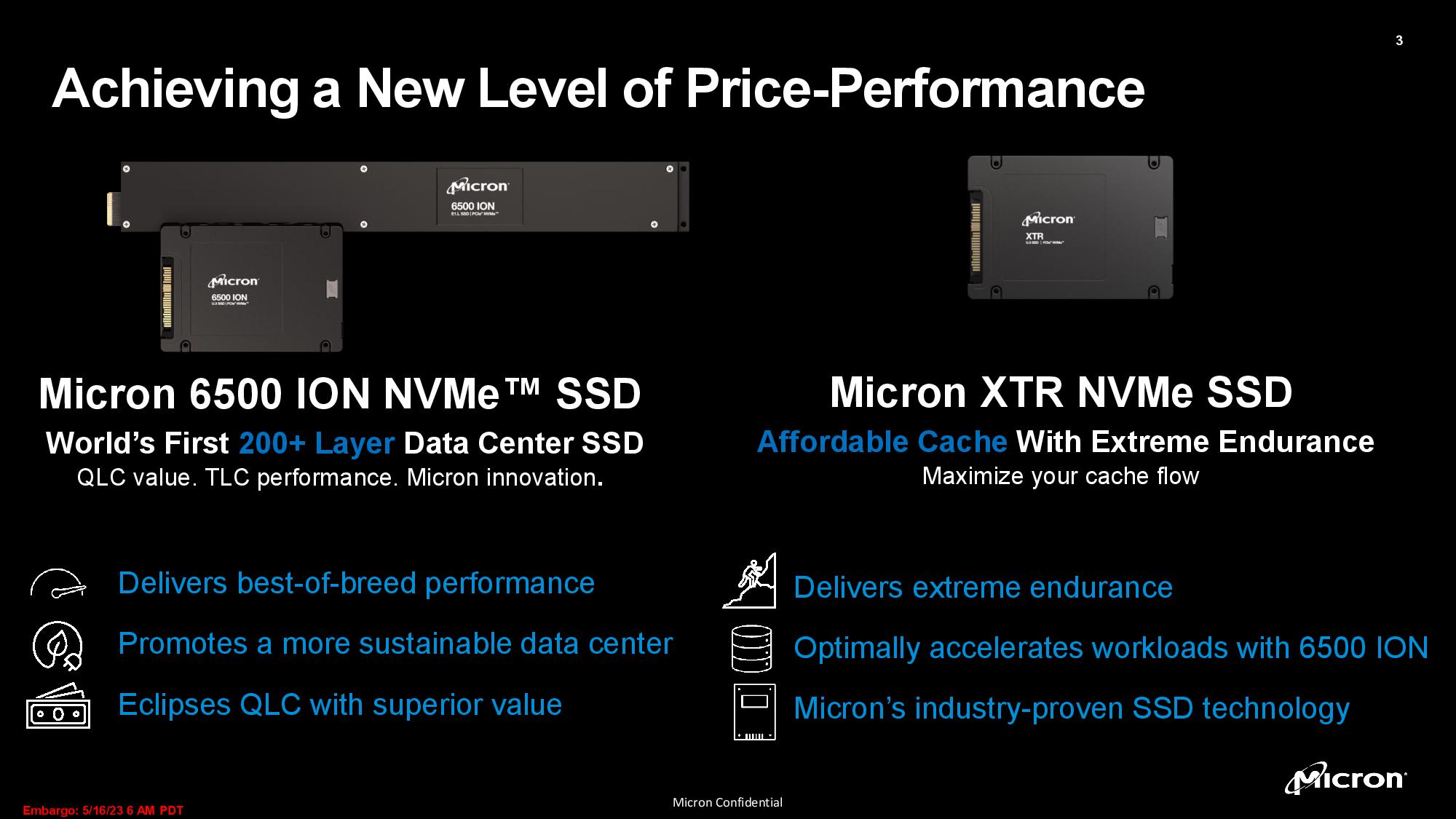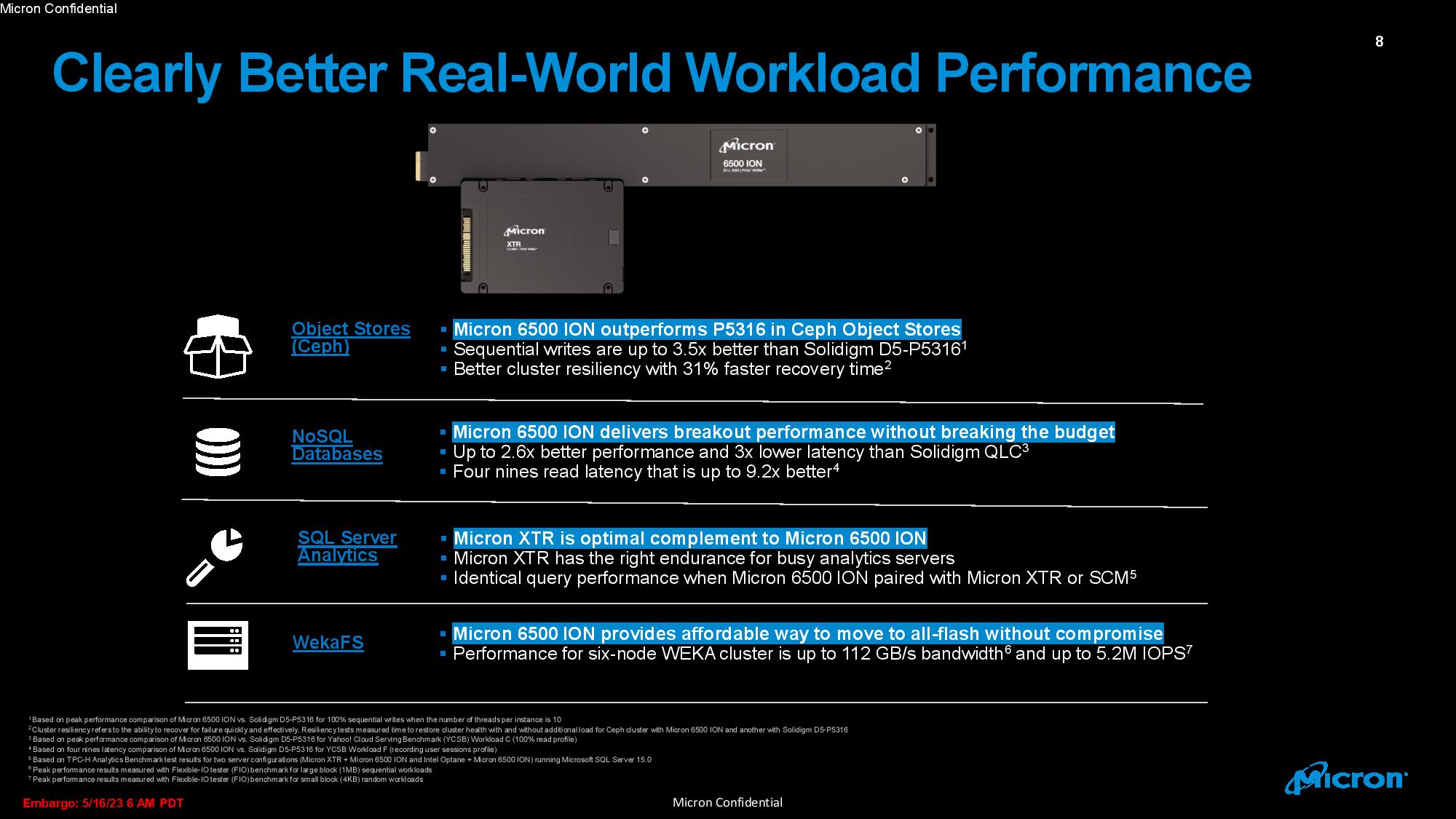
Micron announced its 6500 ION NVMe and the XTR NVMe SSDs today, with both drives designed specifically for workloads and use cases that reside at opposite ends of the data center SSD spectrum. The Micron 6500 ION NVMe SSD is designed for ultra-high-capacity applications - it is only available at a 30.72TB capacity point - to deliver a cost-effective blend of performance and endurance through the use of leading-edge 232-layer TLC NAND. The 6500 ION is the first data center SSD to use 200+ layer flash, which Micron says delivers the economics of QLC flash, yet none of QLC’s other inherent drawbacks, like reduced performance and endurance. The ION’s performance is impressive, too, with up to 6.8 / 5 GB/s of sequential read/write throughput and up to 1 million / 200,000 random read IOPS.



On the opposite end of the spectrum, the much less spacious Micron XTR only comes in 960GB and 1.92TB capacities. The XTR is designed for extreme write environments with an impressive endurance rating of up to 35 random drive writes per day (DWPD), optimizing it as a write target for high-intensity applications. The XTR is plenty fast in sequential work, with up to 6.8 / 5.6 GB/s of read/write throughput, but really shines in heavy 4K random workloads, where it delivers up to 900,000 / 350,000 random 4K read/write IOPS.





Micron usually waits for its lead-edge flash to mature, which confers endurance and performance benefits, before using it for data center SSDs. This time, instead of waiting, Micron instead forged its 6500 ION with its leading-edge 232-layer flash, thus allowing it to deliver high-capacity SSDs that are more endurant and faster than QLC SSDs. For instance, the competing Solidigm D5-P5316 also comes at a 30.72TB capacity point, but it uses lower-endurance 144-Layer QLC flash. These two drives have comparable capacity, but different target markets – the P5316 is designed for read-centric workloads, while the 6500 ION has enough endurance to target general-purpose workloads. However, Micron says the 6500 ION will be available at a similar price point to the P5316, making it the most logical comparison.
QLC flash has only recently begun to make inroads into the data center, but Solidigm’s leading-edge P5316 SSD accommodates the lower endurance of the underlying flash and reduces the required amount of DRAM capacity by using a 64K indirection layer, which can significantly penalize endurance and performance if data written to the drive isn’t aligned to 64K units. As such, the Solidigm QLC drives require 64K-tailored operating systems and software stacks to extract the best performance and endurance.
Outside of the large hyperscalers, there aren’t many enterprise or general-purpose data centers that have tight enough control of the various application and software stacks to support a 64K alignment. In contrast, the higher-endurance TLC used in the 6500 ION allows Micron to use a standard 4K indirection layer widely supported by most applications, so the drive doesn’t require as much handholding to ensure performance and endurance.
The 6500 ION comes in both the 15mm U.3 form factor and as a 19mm E1.L ‘ruler.’ The 6500 ION reaches 6.8 GB/s in sequential read workloads, but the read-optimized Solidigm drive reaches 7 GB/s. Micron’s use of TLC flash allows it to deliver more performance in sequential workloads, though, with its 5.8 GB/s of sequential throughput outweighing the P5316’s 3,600 MB/s. The 6500 ION also leads with 1 million 4K random read IOPS compared to the P5316’s 800,000 IOPS.
The biggest difference between the drives resides in the random write performance. Micron claims the 6500 ION’s 200,000 random 4K write IOPS is 30 times faster than the random write performance of the P5316, but that isn’t the best comparison – the P5316 is designed and marketed specifically for 64K-optimized environments and isn’t intended to be used with heavy 4K random write workloads. Instead, Solidigm rates the P5316 at 510 MB/s of random 64K writes, and Micron doesn’t publish a similar metric for the ION, so comparisons aren't entirely apples-to-apples.
The 6500 ION features 1 DWDP (drive write per day) of endurance in sequential workloads, and 0.3 DWPD in random workloads. Micron also calls out that it has 10X the endurance of the competing Solidigm drive in 4K random write workloads, which is true given that writing a 4K block to the 64K-optimized drive increases write amplification tremendously. But, again, this isn’t an entirely apples-to-apples comparison: When used as intended, the 30.72TB P5316 delivers ~0.4 DWPD of endurance in 64K random workloads, and ~1.9 DWPD of endurance in sequential workloads. The downside, of course, is that these values only apply in highly-specialized environments.
In either case, Micron’s aggressive price matching is intended to bring the two drives to a level playing field where it can leverage the benefits of its 4K indirection unit compared to the P5316’s 64K implementation. Of course, we always take vendor-provided metrics with a grain of salt (we’re conducting our own tests). Still, as you can see in the slides above, Micron claims the 6500 ION delivers tangible performance advantages over the P5316 when used in general-purpose workloads.
The 6500 ION holds plenty of advantages over the similarly priced P5316 in standard server environments, and the ease of use makes it attractive for mainstream data centers and enterprise workloads. Naturally, we do expect that Solidigm will introduce newer QLC SSDs soon with better performance metrics than its existing model, which we’ll link to when an announcement occurs.

The 6500 ION is designed to accommodate almost all general-purpose workloads, but there are always applications that require heavier write endurance and faster random write performance. That is where the Micron XTR steps in, focusing on providing enough endurance to satisfy write-heavy workloads, like write caching and buffering (for all-flash arrays, too), logging, journaling, and OLTP applications.
However, while Intel’s Optane and Toshiba’s XL-flash powered FT6 SSD are geared for both ultra-low-latency performance and incredible endurance, the XTR isn’t designed for workloads that require extremely low-latency – instead, the focus is purely on random write performance and endurance.
The specialized media used in drives like Optane and XL Flash require dedicated production lines, whereas the XTR uses Micron’s tried-and-true 176-layer flash to ensure a robust supply. Micron then programs the flash to work purely in SLC mode, thus delivering up to 35% of the endurance of Optane but at 20% of the cost. The drive also consumes 44% less power than storage class memories, like Optane.
The drives come in 960GB and 1.92TB capacities, with the larger model offering up to 6.8 / 5.6 GB/s of sequential read/write throughput in tandem with up to 900,000 / 350,000 random read/write IOPS. That’s 150,000 more random write IOPS than Micron’s own 6500 ION.
The XTR can take a hammering with up to 60 DWPD of endurance in sequential workloads and 35 DWPD of random 4K workloads, easily beating any competing NAND-based SSDs. Intel is no longer producing new Optane media, so the market is ripe for a drive that can target the high-endurance segment, and here the XTR looks well-positioned to gain a foothold in the target applications.

Naturally, a drive that peaks at a 1.92TB maximum capacity will only serve in very specific use cases, and Micron positions this as an optional write buffer for arrays of its 6000-series SSDs. As you can see, the XTR and 6500 ION plug right into the rest of the Micron data center SSD stack, giving its customers a broad range of choices in terms of both the target workloads and form factors.
Both the 6500 ION and the XTR are shipping to select Micron partners this month, with broader availability to others coming next month.







